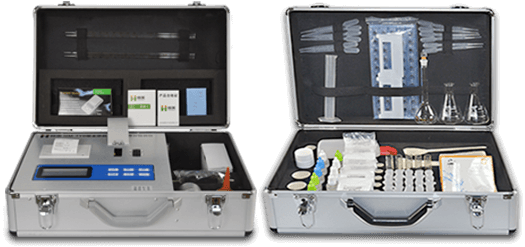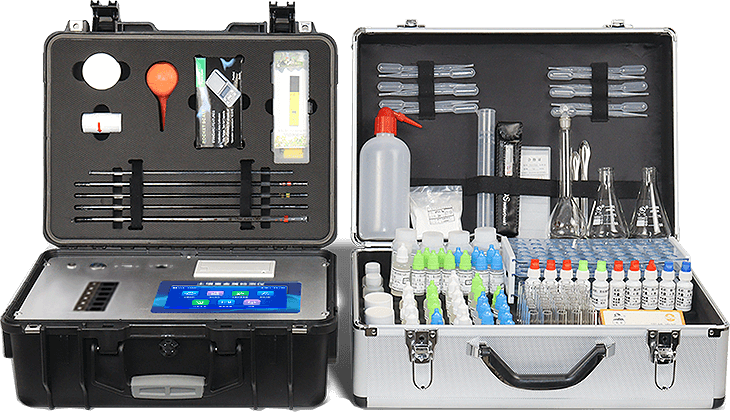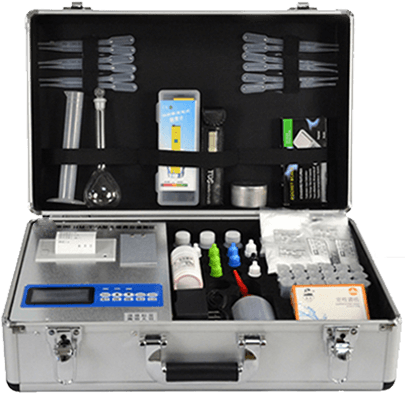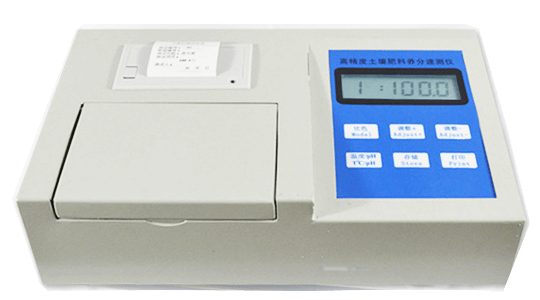
Organic fertilizer tester
- Product Number:LD-FB
- Product Difference:Testing for various trace elements and heavy metal content in chemical fertilizers, organic fertilizers (including foliar fertilizers, water-soluble fertilizers, and spray fertilizers), and biological fertilizers
Product Introduction
The organic fertilizer tester is fully functional and covers all domestic and international testing items (all types of reagents are available for purchase). The instrument integrates reagents, equipment, and instruments into one unit, making it easy to carry and equivalent to a small laboratory. It is suitable for soil testing and fertilizer application in agriculture and fertilizer manufacturing, as well as for identifying the authenticity of fertilizers. It is easy to operate and fast, with ready-to-use reagents that require no preparation.
It can test the following items:
1. Fertilizer nutrients:
① Nitrogen, phosphorus, and potassium in single-component fertilizers.
② Ammonium nitrogen, nitrate nitrogen, phosphorus, potassium, and urea in compound (mixed) fertilizers and urea.
2. Organic fertilizer nutrients:
① Available nitrogen, available phosphorus, available potassium, total nitrogen, total phosphorus, total potassium, organic matter, and various humic acids in organic fertilizers.
② Trace elements (calcium, magnesium, sulfur, iron, manganese, boron, zinc, copper, chlorine, silicon, molybdenum), etc.
③ Various heavy metals (lead, chromium, cadmium, mercury, arsenic, nickel, aluminum, fluorine, titanium, selenium)
Product Features
Nationally patented design for the “Integrated Aluminum Alloy Case for Equipment and Reagents,” featuring portability, durability, and compatibility with testing methods and finished reagents.
Resolution: 0.001, touch-sensitive buttons, built-in next-generation thermal printer capable of printing test results.
The colorimetric cell section features a single-channel design with no mechanical displacement or wear, ensuring accurate optical path alignment and precise measurement results.
Microcomputer-controlled with digital circuitry and programmable design, LCD display, compatible with both AC and DC power, test data can be stored and retrieved, suitable for field testing, significantly reducing operator errors and labor intensity.
High-brightness LED light source with filter-based processing ensures stable light source wavelength. Silicon semiconductor as the signal reception system, with a lifespan of up to 100,000 hours. Stable light source, good reproducibility, and high accuracy.
Tests for available nitrogen, available phosphorus, available potassium, total nitrogen, total phosphorus, total potassium, organic matter, pH, as well as various trace elements such as calcium, magnesium, sulfur, iron, manganese, boron, zinc, copper, chlorine, silicon, and molybdenum, and heavy metals such as lead, chromium, cadmium, mercury, arsenic, nickel, aluminum, fluorine, titanium, and selenium.
Product parameters
| Power Supply | AC 220±22V, DC 12V+5V (can use vehicle power supply or opt for built-in lithium battery) |
| Power | ≤5W |
| Range and Resolution | 0.001-9999 |
| Stability | After 5 minutes of preheating upon startup ① No drift in displayed values within two minutes (transmittance measurement), within three minutes, drift is less than 0.2% (0.002, transmittance measurement), and within five minutes, numerical drift does not exceed 0.3% (transmittance measurement) ② Within twenty minutes, numerical drift does not exceed 0.5% (transmittance measurement) or 0.001 (absorbance measurement) ③ Within 30 minutes, the numerical drift does not exceed 0.7% (transmittance measurement) or 0.002 (absorbance measurement) |
| Linear error | ≤1% (0.01, copper sulfate detection) |
| Repeatability error | ≤0.3% (0.003, potassium dichromate solution) |
| Sensitivity | Red light ≥4.5 ×10⁻⁵, blue light ≥3.17×10⁻³, green light ≥2.35×10⁻³, Orange light ≥ 2.13 × 10⁻³ |
| Wavelength range | Red light 680 ± 2 nm, blue light 420 ± 2 nm, green light 510 ± 2 nm, orange light 590 ± 4 nm |
| Testing speed | Testing one composite fertilizer sample (N, P, K) ≤ 50 minutes, with an additional 20 minutes for each additional fertilizer sample |
| Testing error | Single fertilizer item error ≤1%, total error for N, P, and K ≤2% |
| Data Printing | Built-in new one-button thermal printer |

 +86 19353291814
+86 19353291814
 +86 19353291814
+86 19353291814



